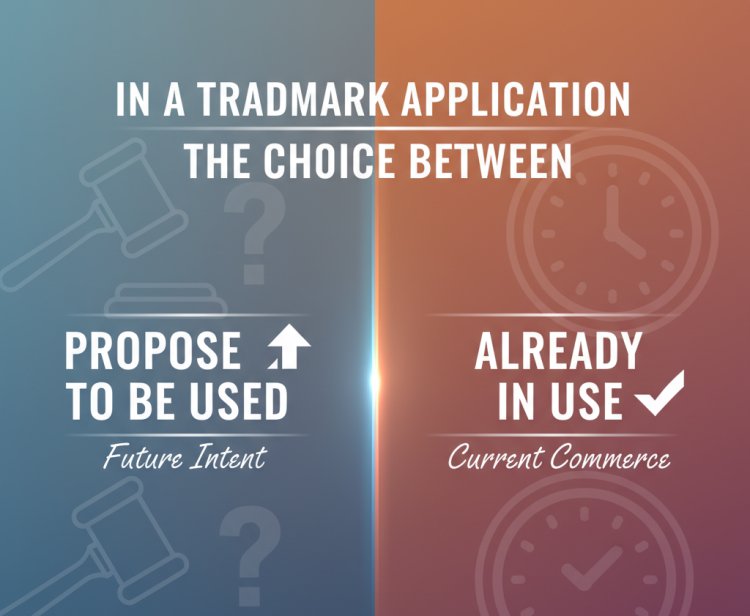IN A TRADEMARK APPLICATION, THE CH0ICE BETWEEN “PROPOSE TO BE USED” AND “ALREADY IN USE
This blog explores the crucial distinction between filing a trademark as “proposed to be used” and “already in use” under the Indian Trade Marks Act, 1999. It explains how this choice impacts the legal strength, enforceability, and long-term protection of trademark rights. The article analyzes both filing bases — their requirements, advantages, and limitations — supported by landmark Indian court interpretations of “use.” It also highlights how strategic selection between intent-to-use (ITU) and actual-use filings can affect brand protection, priority claims, and registration validity, emphasizing the risks of misrepresentation and the importance of accurate filing strategy for businesses.

INTRODUCTION
Under Indian law, trademarks are governed primarily by the trademarks act, 1999 and administered through the trademark’s rules,2017. Application can claim either “proposed to be used” (intent to use) or “already in use” (prior use) status, which has substantial legal and procedural implications. trademarks are more than just logos or names- they embody brand reputation, customer trust, and market identity. From startups to global corporation, trademark is crucial for business survival in a competitive environment.
When filing a trademark application in India, the choice between “[proposed to be used” and “already in use” can determine how strong and enforceable your rights will be. This is not a mere procedural requirement but a legal declaration that influences how the registry examines the application and how courts evaluate disputes.
1. PROPOSED TOO BE USED TRADEMARKS
DEFINITION:
A “proposed to be used” trademark application indicates that the applicant intent to use the mark commercially in indie in the future, but has not yet commenced use. The UTI(INTENT-TO-USE) basis is a strategic maneuver for the future-minded business.it is a legally binding declaration that you have a Bonafide intension to use the mark in commerce soon, even though you have not yet launched your product services.
KEY FEATURES:
· BONAFIDE INTENSION: the applicant must genuinely plan to use the mark for the indicated goods/services within India.
· NO EVIDENCE OF USE REQUIRED AT FILING: documentary proof or sales records are not necessary upon submission
· REGISTRATION RISK: if the mark is not used within five years of registration, it can be cancelled under section 47 for non-use.
· LITIGATION IMPLICATION: in infringement proceedings, the proprietor bears the burden of proving actual use; legal rights are generally weaker than for marks already in use.
· BUSINESS FLEXIBILITY: this filing allows securing priority rights while preparing for product/ service launch.
RELEVANT PROVISONS:
· SECTION 18, TRADE MARKS ACT, 1999: grants the right to file on a propose-to-be used basis.
· RLE 25, TRADE MARKS RULLES, 2017: addresses affidavit and evidence if claiming actual use subsequently.
PRACTICAL USE:
Business often files on this basis to reserve a trademark before commencing commercial operations, thereby creating priority for future use.
To know more about this you can follow the link below:
2. ALREADY IN USE (PRIOR USER) TRADEMARKS
DEFINTION:
An “already in use” trademark filing refers to marks that are currently in commercial use in India. A trademark is filed as “already in use” when the applicant has already used the mark in trade. In such cases, evidence of use must be provided (e.g., invoices, packaging, websites content, promotional materials).
KEY FEATURES
· Proof of prior use is mandate.
· Strengthens claims of distinctiveness and good will.
ADVANTAGES
· LEGAL STRENGHT: continuous prior support ownership and reputation claims.
· DEFENSIVE PROTECTION: evidence helps in opposition and infringement cases.
· MARKET RECOGNITION: establishes acquired distinctives.
LIMITATION
· False claims can lead to rejection or cancellation.
· Requires well-maintained records of usages.
3. LEGAL IMPLICATION & CASE LAWS
THE INDIAN COURTS HAVE CLARIFIED WHAT CONSTITUTES “USE” UNDER TRADEMARKS LAW. A FEW IMPORTANT CASES:
(a). Hardie Trading Ltd. v. Addisons Paints (2003)
The supreme court held that “use” of trademark is not limited to physical sale of goods; even preparation to use, such as advertisement, can constitute genuine use if done in good faith.
(b). Toyota Jidosha Kabushiki Kaisha v. Prius Auto Industries (2018)
The supreme court ruled that prior international use of the mark “prius” did not automatically establish goodwill in India. The defendant, Prius Auto, was using the mark in India since 2001 and acquired distinctiveness.
(c) . Cadbury India Ltd. v. ITC Ltd. (2013)
Cadbury filed against ITC for using “Eclairs.” The Delhi High Court observed that the burden lies on the party claiming “Prior use” to establish continuous and substantial use with evidence.
CONCLUSION
The choice between “Proposed to be used” and “Already in use” in a trademark application is not merely procedural but highly strategic. Startups benefit from the flexibility of “propose to be used,” while established businesses rely on the strength of “Already in use.”
As judicial precedents show, the Indian courts give considerable weights to genuine use supported by evidence. Misrepresentation or non-use can jeopardize rights. Therefore, applicants must carefully evaluate their business stage, evidence availability, and long-term brand strategy before choosing the correct declaration.
Filing the right application ensures compliance with the Trademarks act, 1999, strengthens brand identity. And help safeguard intellectual property in a competitive marketplace.












